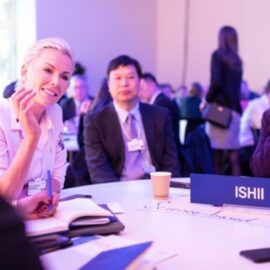

This article is an excerpt from the Shortform book guide to "Hit Refresh" by Satya Nadella. Shortform has the world's best summaries and analyses of books you should be reading.
Like this article? Sign up for a free trial here.
Does your company have a fixed mindset or a growth mindset? How can a growth mindset help you learn from your mistakes and make breakthroughs?
By 2014, a fixed mindset had caused Microsoft to lag behind its competitors. When Satya Nadella became CEO that year, he began to cultivate a growth mindset. That change helped unleash Microsoft’s innovative energy and put the company back at the forefront of its industry.
Read more to learn about the importance of a growth mindset in business.
Adopting a Growth Mindset in Business
According to Satya Nadella, a growth mindset in business is essential—a lesson that plays out in his story. He writes that Microsoft had become stagnant at the time he became CEO. While the company led the “PC Revolution” of the ’80s and ’90s, Nadella argues that it had a “fixed mindset”—it rested on its past successes instead of continuing to take risks and push innovative tech products. With the advent of mobile phones and iPads, its rivals started to pull ahead.
(Shortform note: In The Infinite Game, Simon Sinek cites Microsoft as an example of a company that practiced “finite” thinking—essentially a fixed mindset that leads to short-lived companies. He argues that Microsoft under Steve Ballmer was focused on how it could beat Apple and thus based its decisions on Apple’s moves. In contrast, he writes that Apple practiced “infinite” thinking. It was proactive rather than reactive and focused on improving customer experience through innovation.)
Nadella argues that no company can afford to retain a fixed mindset and get too comfortable in a fast-changing environment. Instead of sticking to what it has always done well and seeking short-term gains, companies should attempt to plan ahead by anticipating the next big trends and seeking to address them. Nadella helped break Microsoft out of its fixed mindset by adopting a “growth mindset,” which enabled the company to regain the initiative instead of falling behind in technological trends. Risk-taking and innovation became the order of the day instead of playing it safe, leading to new opportunities in AI and cloud computing and changing the general atmosphere at the company.
(Shortform note: Having a growth mindset is just as important in your personal life as it is in a company. In Grit, Angela Duckworth writes that people who have a growth mindset believe that they can get smarter or more talented over time if they put in the work and are given the right opportunities. They’re more likely to persevere despite obstacles and failure. In contrast, people with a fixed mindset believe that intelligence and talent are static, and thus attribute their failures to something they believe they’ll never have.)
In addition, Nadella believes a growth mindset means that you learn from your mistakes. While many things had gone wrong at Microsoft in the years before Nadella took over as CEO, having the courage to confront those mistakes and finding a way forward was instrumental in the company’s rejuvenation.
He uses Nokia as an example: Microsoft had acquired Nokia for $7.2 billion in the hopes of bolstering its smartphone presence but ultimately decided to write it off. (Nadella notes that he voted against the acquisition, which was put into motion before he took over as CEO.) He says that letting go of so many talented people was heartbreaking but that the Nokia experience taught him many lessons. For one, he learned that they should only be in businesses where the company has a strong differentiator.
(Shortform note: Nadella’s approach to mistakes is similar to Pixar co-founder Ed Catmull’s. In Creativity, Inc., Catmull writes that Pixar embraces failure because it’s an inevitable result of innovation—if you don’t take risks, you won’t be able to come up with something original. To take the stigma out of failure, he recommends admitting your own mistakes and explaining how you moved forward. You should also take the pressure off managers to perform perfectly and encourage them to create an environment where employees can fail and recover.)

———End of Preview———
Like what you just read? Read the rest of the world's best book summary and analysis of Satya Nadella's "Hit Refresh" at Shortform.
Here's what you'll find in our full Hit Refresh summary:
- How Satya Nadella brought Microsoft back from its decline
- Actionable advice to help you reinvigorate your company
- A look at the ethical responsibilities of tech companies






